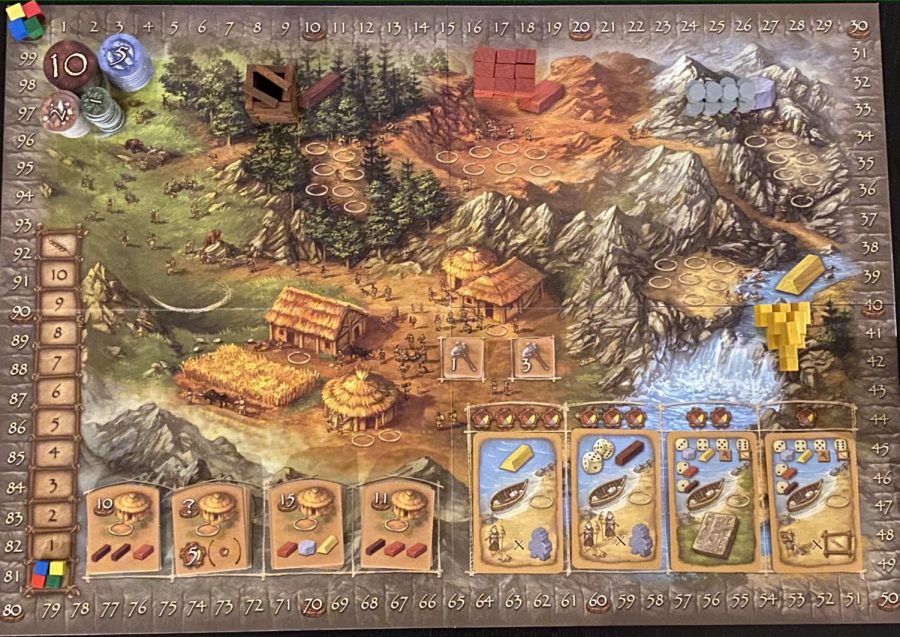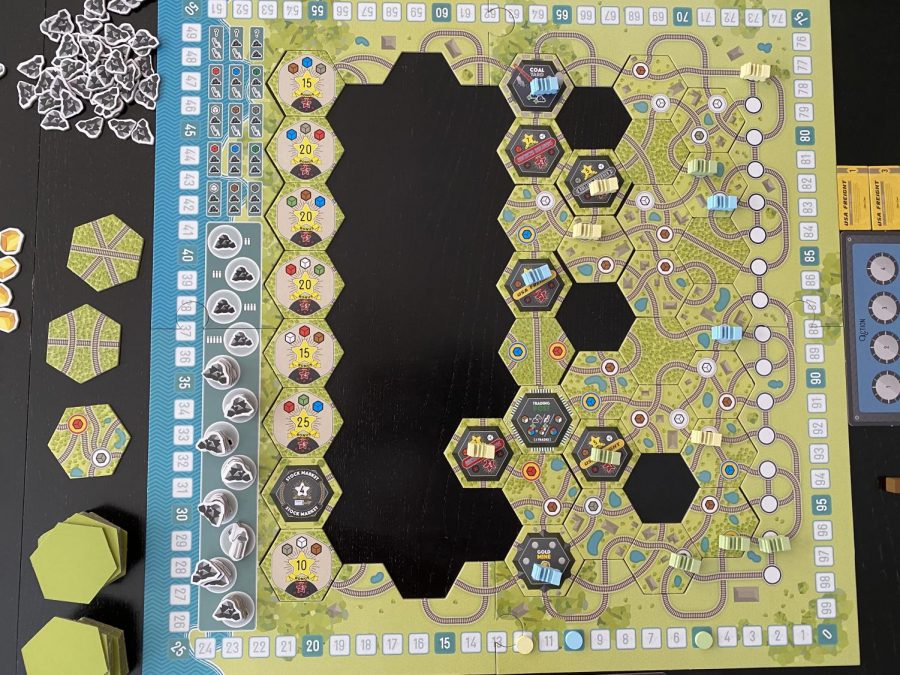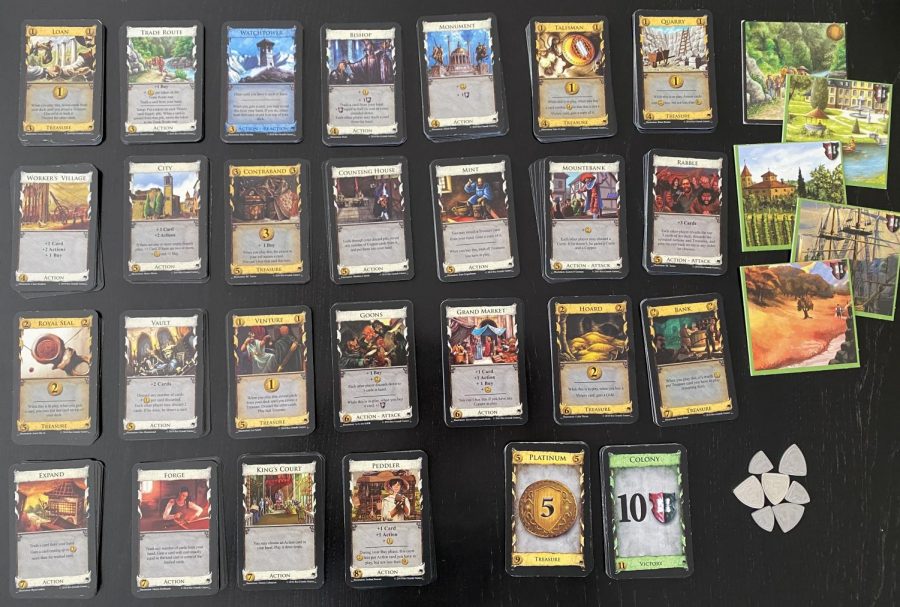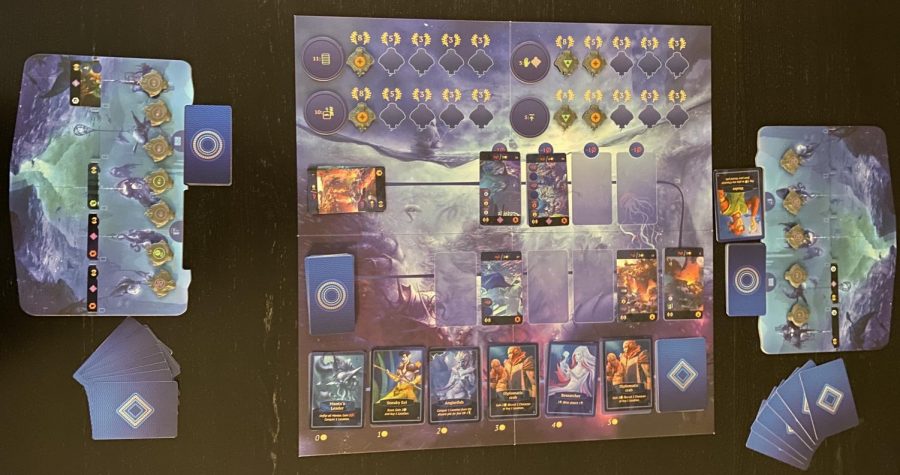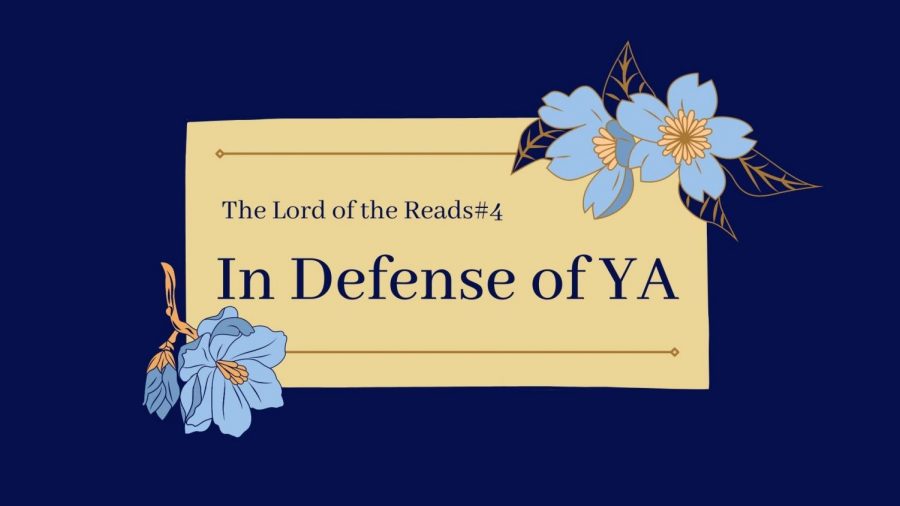Travel back in time to the Stone Ages, where people wrote on tablets and built tools by hand. In Stone Age, published by Z-MAN Games, players will place workers at various locations around the game board to get resources, food, and expand their civilization. Players score points by completing buildings and collecting civilization cards, which have a variety of scoring effects. Let’s take a look at what it takes to dominate the Stone Ages.
How to Play
The game takes place over a series of rounds. Beginning with the start player, players take turns placing any number of workers at one location on the board. The game has circles at each location. There can be only one worker per circle at a location, and a player cannot place workers somewhere they already have workers.
Once all players have placed their workers, players take turns removing their workers from a location to take the action of the place those workers were at. In the center of the board are three actions for upgrading your technology. These actions will help players be more efficient, thus allowing them to get more things done during each round. There are only enough circles for one player to take each of these actions. One of the places gives the player an additional worker to use in future rounds. Another site provides the player with a tool. The third action increases that player’s food production by one step. I’ll explain what tools and food production do a little later.
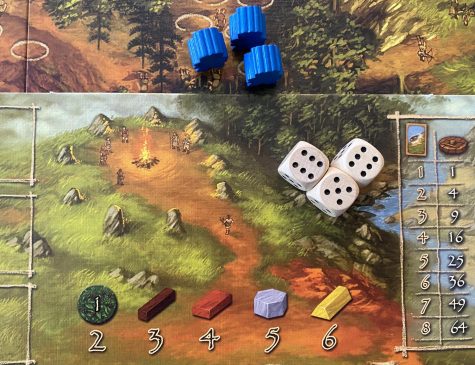
Player boards tell players what number to divide by. In addition, players keep their resources, tools, and constructed buildings on the indicated areas of their personal board The right side of that board shows how civilization cards score at the end of the game.
A large section of the board has the areas for getting resources. Up to seven workers can be placed at each of those locations except for food, which is open to any number of workers. When a player resolves an action at a resource area, they roll one dice per worker they placed. The player divides the total of the dice by the value of the resource. In the example shown on the right, the player has three workers at the wood area, so they roll three dice. The sum of the dice is 17, so the player divides 17 by three, the value of the wood, and receives five wood. If these workers were at the gold area, then the player would do 17 divided by six and therefore receive two gold. Tools can be used after rolling the dice to increase the sum.
One corner of the board has stacks of building tiles. A player can place a worker on an unoccupied building stack. When resolving that action, the player may spend the resources shown on the building to score the number of points shown on the tile immediately. If a player constructs the last building from a stack, the game will end after the current round ends.
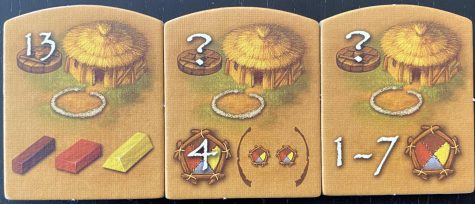
The building on the right requires one wood, one brick, and one gold. The building in the middle requires a total of four resources that include exactly two different resource types. The building on the right requires one to seven resources in any combination.
In the other corner of the board are four civilization cards. Each card can hold one worker. When resolving the action there, a player must pay 1-4 resources to take the card. Each card is divided into two sections. The top section shows an immediate bonus, such as getting resources or food production. The bottom part of a card shows how it scores. Cards with green backgrounds depict different symbols. The player will square the number of different symbols they have and score that many points. Other cards will give the player points based on the number of buildings constructed, tools obtained, food production level, or workers the player has. All cards are scored at the end of the game. At the end of each round, the face up civilization cards slide down, so expensive cards will be cheaper in the next round. If there are not enough cards to refill the row, the game ends immediately.
After all players resolve their actions, each player must pay one food per worker they have. Players that don’t have enough will lose resources and possibly receive a 10 point penalty. Before players pay, they receive food based on their food production level.
When one of the two end game conditions is met, players will count their points from civilization cards. The player with the most points is the winner.
Final Thoughts
There are a lot of things in Stone Age that I like, but there are also quite a few things that I don’t like. Let’s start with some of the good aspects of the game.
First of all, I like the artwork and components of the game. Instead of using standard looking meeples, the workers in this game look like they came from the Stone Age. The resources are not just colored cubes but shaped to represent that resource. The board looks excellent, and the card artwork is beautiful as well.
However, games are more than just looks, and Stone Age does have more to it. My favorite part of the game is that there are multiple paths to victory. One strategy is to get lots of buildings from the same pile to end the game quickly before a player can acquire a lot of civilization cards. Another approach is to get a lot of food production, tools, or buildings and then aim for the cards that score points for having those things. While doing all that, a player could score a lot of points from collecting different symbols on their cards.

The longer the game lasts, the more time players have to capitalize on civilization cards. More time means that players can get additional symbols or can collect more tools and food production. However, it seems like doing the same thing as the rest of the players is beneficial. For instance, if more players go for buildings, the game will end faster, when civilization cards are less valuable. If more players go for civilization cards, the game will take longer, which makes those cards worth more than most buildings.
The game has one flaw, which is that the only way to get a lot of resources is to roll the dice. While the resources have different values, the most significant impact is made by what numbers you roll and how many dice you roll. I get how dividing the total of the dice by the resource’s value is thematic, but it is also entirely unnecessary. Furthermore, the number of resources you get from a location is completely based on luck. Tools can help you turn large remainders into an extra resource, but rolling a number where your tools actually do that doesn’t usually happen.
Stone Age is not the only worker placement game. When compared to other games that involve placing workers to get resources, Stone Age lacks a sophisticated method to give resources fairly.
As a worker placement game, another factor to consider is how competitive the board is. When playing with four players, the board will get competitive each round. It is almost certain that another player will take your spot a few times during the game. The game is not so tight that every circle on the board gets filled. In fact, some of the resource areas will not have any competition at all during some rounds. The locations that are more competitive change based on each player’s strategy. Interaction is another area of the game where Stone Age shines because there is a balance between being able to do whatever actions you want and not being able to do anything you want.
As the player count lowers, there are fewer workers for the same amount of circles. The game is still competitive since there is now a limit to how many players can go to each resource location, and only two of three upgrade locations are available. The game still has a proficient balance in competition at the lower player counts.
Food is the most annoying part of the game. Since you need food for each worker, you have to figure out how many of the workers you need to send to get food. The concept of food makes sense thematically but does not work mechanically. Investing in a new worker seems like an advantage, but it also means that you need more food each round. That means you have to send more people to get food, so your extra worker may be useless if it has to get food every round. The game would still be functional and take less time to play if players did not have to struggle for food each round. Nevertheless, some people will still enjoy that mechanism because it is another factor to consider when playing the game.
I go back and forth about whether I like the way the buildings score. The buildings that have set resource costs score points based on the value of the resources needed. The way the points are calculated doesn’t change if the building requires three different resources or two of one kind and one of another type. Fortunately, getting two of the same resource is only slightly easier than getting three different ones, so that’s not an issue.
Buildings without set resource costs tell you how many resources and types you need. These buildings score points based on the value of the resources you use. I prefer buildings with set costs because they are more balanced. The buildings with varied costs are more flexible. However, those buildings require more resources, which takes longer to acquire. I think it’s a unique twist when those buildings appear since players can try to make it worth a lot of points by stockpiling valuable resources. Despite having to calculate the building’s score, I do enjoy having the buildings with four or five resources.
However, I definitely don’t like the buildings that cost 1-7 resources in any combination. These buildings hurt the game because it is too flexible. While one player can try to get a lot of valuable gold and stone to make that building worth a ton of points, another player can block the spot and use a few cheap resources and score a few points.
Despite the mixed review, Stone Age is a solid game that has a role in anyone’s collection. If you aren’t a fan of the mechanisms of this game or already have a worker placement game you love, you most likely do not need to get a copy of this. As the box says, the game takes 60-90 minutes and can have 2-4 players. You can expect to find this game online or in stores dedicated to board games at around $35-$55. I really like the civilization cards, competitiveness, and the stunning components. Still, due to the luck to get resources, annoying struggle to feed workers, and a few unbalanced buildings, I give this game a 6.5 out of 10.
[star rating=”3.25″]

